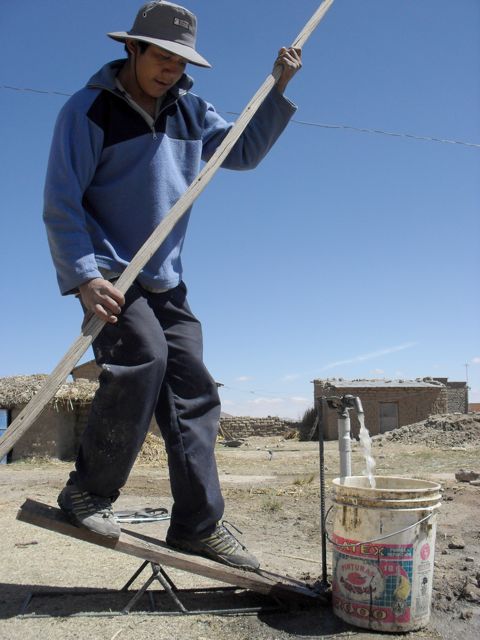Difference between revisions of "EMAS pedal pump"
| Line 1: | Line 1: | ||
__NOTOC__ | __NOTOC__ | ||
[[Image:EMAS_pedal1.jpg|thumb|right|150px|An EMAS pedal pump used near the EMAS training center in Puerto Perez, Boliva]] | [[Image:EMAS_pedal1.jpg|thumb|right|150px|An EMAS pedal pump used near the EMAS training center in Puerto Perez, Boliva]] | ||
| − | [[Image:EMAS_pedal2.jpg|thumb|right|150px|An EMAS pedal pump]] | + | [[Image:EMAS_pedal2.jpg|thumb|right|150px|An EMAS pedal pump installed at a underground cistern used for rainwater catchment, Bolivia]] |
The EMAS pedal pump is a standard [[EMAS pump|EMAS hand pump]], combined with a mechanism that allows the pump to be operated by foot. In that way, more water can be pumped without the operated getting tired. The EMAS pedal pump can both be used for household drinking water and for irrigation. As the construction is very simple, a minimum of material is used, and the pump is very affordable. | The EMAS pedal pump is a standard [[EMAS pump|EMAS hand pump]], combined with a mechanism that allows the pump to be operated by foot. In that way, more water can be pumped without the operated getting tired. The EMAS pedal pump can both be used for household drinking water and for irrigation. As the construction is very simple, a minimum of material is used, and the pump is very affordable. | ||
Revision as of 18:18, 16 December 2009
The EMAS pedal pump is a standard EMAS hand pump, combined with a mechanism that allows the pump to be operated by foot. In that way, more water can be pumped without the operated getting tired. The EMAS pedal pump can both be used for household drinking water and for irrigation. As the construction is very simple, a minimum of material is used, and the pump is very affordable.
EMAS pumps can generate pressure and can thus be used to pump water from a well to a water tank, located, for example, under the roof of a home. In that way, running water in the kitchen becomes possible. Another possibility is to pump the water horizontally over a distance, up to a maximum of 2km. Pumping straight from a well to a tank ensures that the water quality remains good, as no recontamination can take place.
History and social context
EMAS is the acronym for Escuela Móvil de Agua y Saneamiento (Mobile School for Water and Sanitation), in Bolivia, whose director, Wolfgang Eloy Buchner, developed this pump in 2008.
EMAS is not only the name of the mobile school for water and sanitation, but also a whole technical and social concept of water and sanitation which includes rain water harvesting, solar water heaters, windpower, hydraulic rams, water treatment, small tanks and sinks, a variety of hand and foot pumps, and ferrocement tanks.
Suitable conditions
| Advantages | Disadvantages/limitations |
|---|---|
| - Foot operated - Can create pressure |
- Only for family use
- not suitable to be used by larger groups |


